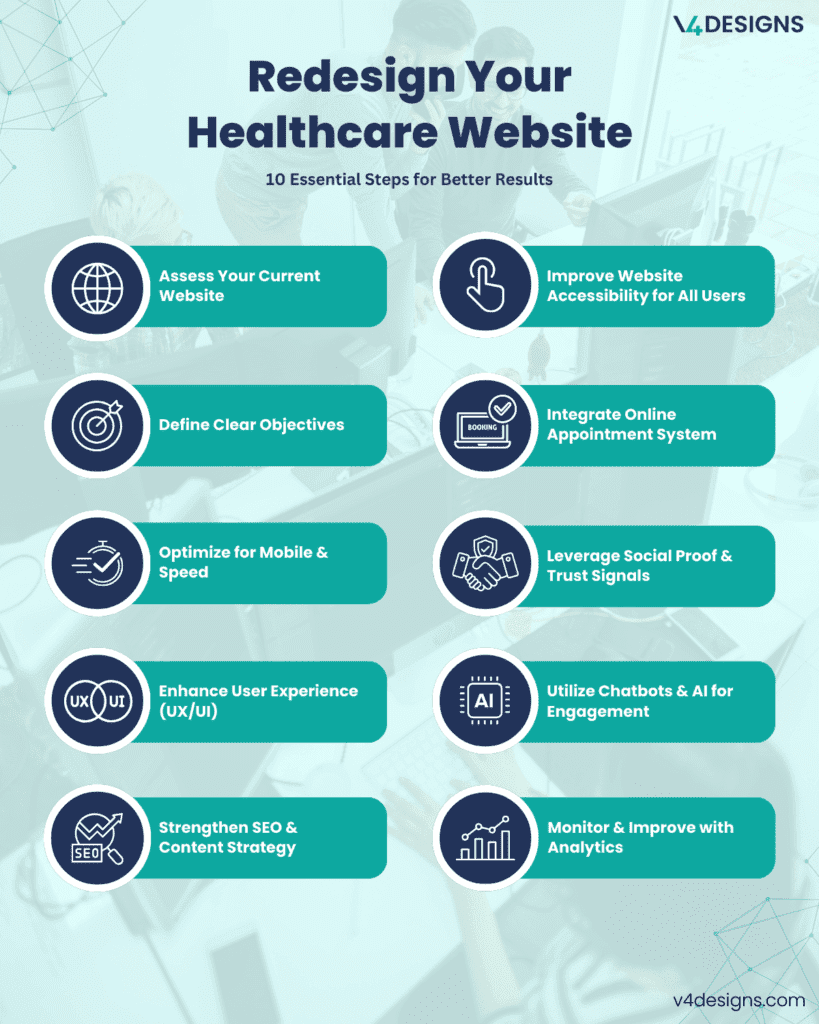Is your healthcare website struggling to engage patients, deliver information effectively, or convert visitors into appointments? Healthcare Website Redesign might be the solution you need. You’re not alone—many healthcare providers face these challenges. A poorly designed healthcare website can lead to frustrated users, missed opportunities, and a tarnished reputation. The good news? A healthcare website redesign can transform your online presence, improve patient satisfaction, and drive better results.
In this guide, we’ll walk you through the essential steps to redesign your healthcare website, offering actionable healthcare web design tips to ensure your site is functional and user-friendly. Let’s dive in!

Why Your Healthcare Website Needs a Redesign
Healthcare websites encounter distinct challenges. They need to strike a balance between offering essential medical information, ensuring accessibility, and building user trust, all while providing a smooth experience. Unfortunately, numerous healthcare websites do not meet these expectations, resulting in:
- Poor user experience: Confusing navigation, slow load times, and outdated designs frustrate users.
- Low patient engagement: Visitors may leave without booking appointments or accessing vital resources.
- Non-compliance risks: Failing to meet accessibility or privacy standards can result in legal issues.
- Outdated content: Inaccurate or stale information can erode trust in your practice.
If your website isn’t delivering the results you need, consider a healthcare website redesign.
How This Problem Affects You
Consider this: A potential patient comes to your website to explore your services or schedule an appointment. Instead, they encounter a messy layout, broken links, and a design that doesn’t work well on mobile devices. Frustrated, they decide to leave and opt for a competitor with a more refined online presence.
This situation isn’t just a possibility—it’s a reality for healthcare providers every day. Your website frequently serves as the first point of contact for patients. If it fails to create a positive impression, you risk losing their trust, credibility, and ultimately, revenue.
Key Steps to Identify the Right Redesign Strategy
Before diving into a redesign, it’s crucial to assess your current website and identify areas for improvement. Here’s how to get started:
1. Audit Your Current Website
- Analyze user behaviour using tools like Google Analytics.
- Identify pages with high bounce rates or low engagement.
- Check for broken links, outdated content, and slow load times.
2. Understand Your Audience
- Define your target audience (e.g., patients, caregivers, medical professionals).
- Research their needs, preferences, and pain points.
3. Benchmark Competitors
- Study competitors’ websites to identify best practices and gaps.
- Look for trends in design, functionality, and content.
4. Set Clear Goals
- Determine what success looks like (e.g., more appointments, better patient engagement).
- Align your redesign goals with your overall business objectives.
Actionable Steps for a Successful Healthcare Website Redesign
Now that you’ve identified the issues and set your goals, it’s time to take action. Follow these steps to ensure your healthcare website redesign delivers better results:
1. Prioritize User Experience (UX)
- Simplify navigation with clear menus and intuitive layouts.
- Ensure your website is mobile-responsive for seamless browsing on all devices.
- Use accessible design practices to accommodate users with disabilities.
2. Focus on Visual Appeal and Branding
- Choose a clean, modern design that reflects your practice’s professionalism.
- Use high-quality images and videos to engage visitors.
- Maintain consistent branding across all pages.
3. Optimize for Speed and Performance
- Compress images and videos to reduce load times.
- Use a reliable hosting provider to ensure uptime and fast performance.
- Minimize the use of heavy scripts or plugins.
4. Create Patient-Centric Content
- Provide clear, concise information about your services, staff, and facilities.
- Include patient testimonials and success stories to build trust.
- Offer resources like FAQs, blogs, and downloadable guides.
5. Ensure Compliance and Security
- Implement secure, user-friendly forms and patient portals to protect sensitive information and enhance patient trust.
- Use SSL encryption to protect user data.
- Regularly update your website to address security vulnerabilities.
6. Integrate Appointment Scheduling and Telehealth Options
- Add an easy-to-use online booking system.
- Include telehealth options for virtual consultations.
- Send automated reminders to reduce no-shows.
7. Test and Iterate
- Conduct usability testing to gather feedback from real users.
- Monitor performance metrics and make adjustments as needed.
- Continuously update content to keep it fresh and relevant.
Final Thoughts
A well-crafted healthcare website serves as more than just an online brochure; it’s an essential resource for drawing in patients, establishing trust, and expanding your practice. By adhering to this comprehensive guide, you can make sure your healthcare website redesign aligns with your audience’s needs and fulfils your objectives.
Don’t let an inadequate website hinder your progress. Collaborate with V4Designs – Best Healthcare Digital Agency, to develop a website that shines in today’s competitive environment.
Transform Your Website with V4Designs
Ready to take your healthcare website to the next level? At V4Designs, we specialize in creating the best healthcare website design that combines functionality, aesthetics, and compliance. Whether you need a complete overhaul or targeted improvements, our team is here to help.
Contact us today to schedule a consultation and discover how we can transform your online presence. Let’s work together to create a website that delivers better results for your practice and your patients.
Don’t Miss: Paid Ads for Medical Practices
FAQs
1. How often should I redesign my healthcare website?
Aim to update your website every 2-3 years to keep up with design trends, technology advancements, and changing patient needs.
2. What are the key features of a successful healthcare website?
Key features include easy navigation, mobile responsiveness, patient portals, appointment scheduling, and compliance with healthcare regulations.
3. How can I ensure my website is secure and patient-friendly?
Work with a web design agency experienced in healthcare to implement secure forms, data encryption, and user-friendly features that protect patient information while enhancing the overall experience.







